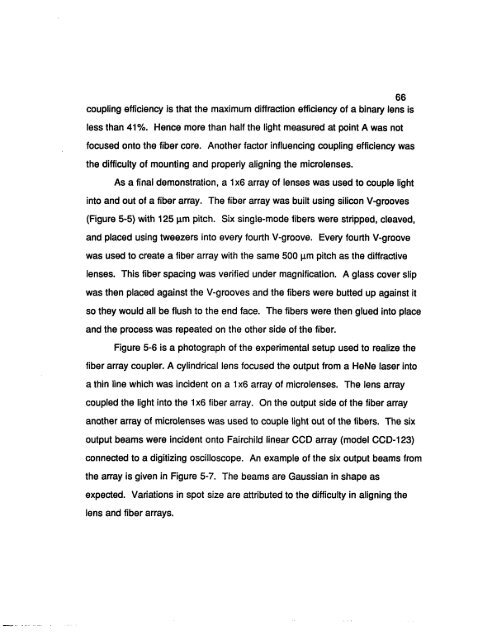azu_td_1349475_sip1_... - Arizona Campus Repository
azu_td_1349475_sip1_... - Arizona Campus Repository
azu_td_1349475_sip1_... - Arizona Campus Repository
Create successful ePaper yourself
Turn your PDF publications into a flip-book with our unique Google optimized e-Paper software.
66<br />
coupling efficiency is that the maximum diffraction efficiency of a binary lens is<br />
less than 41%. Hence more than half the light measured at point A was not<br />
focused onto the fiber core. Another factor influencing coupling efficiency was<br />
the difficulty of mounting and properly aligning the microlenses.<br />
As a final demonstration, a 1x6 array of lenses was used to couple light<br />
into and out of a fiber array. The fiber array was built using silicon V-grooves<br />
(Figure 5-5) with 125 |im pitch. Six single-mode fibers were stripped, cleaved,<br />
and placed using tweezers into every fourth V-groove. Every fourth V-groove<br />
was used to create a fiber array with the same 500 pirn pitch as the diffractive<br />
lenses. This fiber spacing was verified under magnification. A glass cover slip<br />
was then placed against the V-grooves and the fibers were butted up against it<br />
so they would all be flush to the end face. The fibers were then glued into place<br />
and the process was repeated on the other side of the fiber.<br />
Figure 5-6 is a photograph of the experimental setup used to realize the<br />
fiber array coupler. A cylindrical lens focused the output from a HeNe laser into<br />
a thin line which was incident on a 1 x6 array of microlenses. The lens array<br />
coupled the light into the 1x6 fiber array. On the output side of the fiber array<br />
another array of microlenses was used to couple light out of the fibers. The six<br />
output beams were incident onto Fairchild linear CCD array (model CCD-123)<br />
connected to a digitizing oscilloscope. An example of the six output beams from<br />
the array is given in Figure 5-7. The beams are Gaussian in shape as<br />
expected. Variations in spot size are attributed to the difficulty in aligning the<br />
lens and fiber arrays.
















